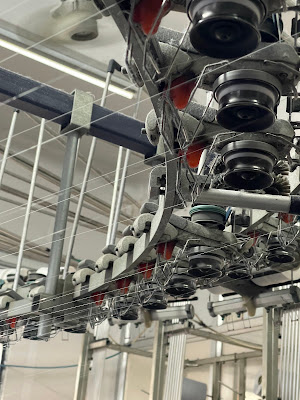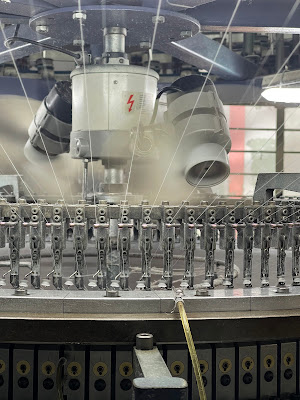Jobs
Because I work in medical education, The Boss took it on himself to organise a tour for me of his family’s hospital. Not the hospital that his family attends: the hospital that they own. His grandfather built the first wing in the 1950s, then his mother built another wing in the 1970s, and now he’s built an entire five storey inpatient facility which just opened last year. Since I was a guest of The Boss, the hospital’s senior directors themselves gave me a two hour guided tour of the campus.
Not gonna lie; I was struggling a little with imposter syndrome as I, in my shorts and my colourful new tiger shirt, was lead about by a trio of executives in smart officewear, men so important that ordinary staff visibly flinched and scuttled out of their way as we swept down the corridors, or relinquished the elevator they’d just called, or pressed themselves into the corners of stairwells as we descended. When we wandered into an open plan administration office, the dozen or so people working there leapt to their feet and remained almost at attention until we wandered out again. Even doctors in the middle of consultations stopped what they were doing and stood up as we passed by. If they discovered how unimportant I actually am, I’m sure they would have broken their Hippocratic Oaths and thrown me off the roof.
When I got back to the house, I was relayed a message from The Boss that we were having lunch at his house. However as I was about to go into the dining room, The Boss beckoned me into his study, with the air of someone about to either ask one for a small favour, or to chastise one for a minor faux pas. As such I entered with a certain amount of trepidation, and he ushered me over to a table where his personal secretary was hovering.
“Which of these,” he asked gravely, “do you prefer?”
On the table were three silver bracelets; one with large, chunky links, one with medium-sized links, and one with sinuous smaller links.
“Uh, the smallest one, I think,” I stuttered.
“Really? Not the medium one?”
Was this a trap, I wondered? If I choose the wrong bracelet, do I get banished from the compound?
“They’re all beautiful,” I said, truthfully. “But you did ask me which one I prefer, and I prefer the little one.”
“Well, then it’s settled,” he said, and he gestured for his valet, who had materialised next to me, radiating disapproval as usual, to fasten it on my right wrist.
As he was doing so, my mother and sisters walked in, and after he’d seated them he drew out several elegant little bags, and gave them to my mother to open. Inside were ornate Indian necklaces, in golden metal, pewter, silver metal and mother of pearl, expensively intricate and delicate, each with matched earrings, rings or cuffs. He asked my mother to go first in choosing which one she wanted. She chose the gold, then one sister chose the mother-of-pearl, and the other chose the silver, with the pewter remaining for my mother to give to her only granddaughter back in Australia.
It’s fair to say that my bracelet is the first real piece of jewelry I’ve ever owned. Everything else has been fast fashion junk, homemade, or the brass thumb ring I found in the gutter in Amsterdam that may actually be a plumbing fitting, and the bracelet that I literally got from a Christmas cracker. The real thing is heavy and cool against my wrist.
After lunch, Mr Fixit drove my sisters and I down to Tiruppur, an industrial hub where The Boss’ textile factories are located, to take a VIP tour of a clothing factory owned by one of The Boss’ fellow industrialists. It was unexpectedly fascinating. We watched the stunningly complex giant looms that weave cotton, polyester and/or bamboo threads into cloth, each one made from a thousand tiny parts carefully put together to ensure perfect weaving. Once woven, the bolts of cloth are unspooled over a lightbox so that workers can check by eye for dyeing flaws, imperfections, rips or bugs that were in the wrong place at the wrong time.
Then we saw the cutting floor, where the cloth is packed into 20cm thick blocks and carved by a CAD-controlled robot bandsaw into the panels of a piece of clothing. From there, the pieces go over to the assembly floors, where hundreds of workers sew sleeves, affix buttons, run elastic through waistbands, stitch in tags or construct collars.
Then it’s up to the embroidery room, where another CAD-controlled robot embroiders the little Nike swoosh, or Puma silhouette, or Lacoste crocodile onto the finished garment.
Finally, we were lead into a large room full of clothing racks, which, I learnt, were samples and end-of-run items left over from the clients’ orders. Given the nature of the manufacturing we’d just seen, it wasn’t surprising that it was all T-shirts, hoodies, polo shirts, tracksuits, leggings, fleece shorts and gymwear.
“Pick out whatever you want,” Mr Fixit declared with uncharacteristic effusiveness. “It’s all free of charge.”
So... there was to be no dance of payment with Mr Fixit today. He had basically told me to go hog wild, with only my sense of common decency and propriety standing between me and the biggest pile of free clothes ever seen.
Over the next half an hour I amassed an embarrassingly large pile, then allowed my dignity to winnow it down to a manageable hoard: a couple of polo shirts, three light track jackets, a tanktop, a pair of fleece shorts, and four T-shirts.
I discovered later that it wasn’t really “free of charge”. It went on The Boss’ tab. But The Boss gets an 80% discount, and that’s off the local price, not the retail price, so a Puma polo that retails for $110AU cost him less than $4AU, and a $75AU Tasc T-shirt cost him around $1.30AU: he got me maybe a thousand dollars of brand-name clothing for less than fifty bucks. You can’t say no to a bargain.





0 Comments:
Post a Comment
<< Home